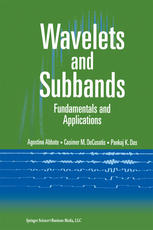

Most ebook files are in PDF format, so you can easily read them using various software such as Foxit Reader or directly on the Google Chrome browser.
Some ebook files are released by publishers in other formats such as .awz, .mobi, .epub, .fb2, etc. You may need to install specific software to read these formats on mobile/PC, such as Calibre.
Please read the tutorial at this link: https://ebookbell.com/faq
We offer FREE conversion to the popular formats you request; however, this may take some time. Therefore, right after payment, please email us, and we will try to provide the service as quickly as possible.
For some exceptional file formats or broken links (if any), please refrain from opening any disputes. Instead, email us first, and we will try to assist within a maximum of 6 hours.
EbookBell Team

5.0
28 reviewsRecently there has been intense research activity on the subject of wavelet and subband theory. Experts in diverse fields such as mathematics, physics, electrical engineering, and image processing have provided original and pioneering works and results. But this diversity, while rich and productive, has led to a sense of fragmentation, especially to those new to the field and to nonspecialists who are trying to understand the connections between the different aspects of wavelet and subband theory. `Wavelets and Subbands' is designed to present an understanding of wavelets and their development from a continuous-domain transformation to a frame representation and finally to multiresolution analysis tools such as subband decomposition. The book presents a theoretical understanding of the subject that is intertwined with practical examples and applications of wavelets in ultrasonic and biomedical domains. There is special emphasis on applications in communications, compression, and image processing. Topics and Features: * Provides an understanding of the link between the continuous wavelet transform, the fast wavelet transform, and subband decomposition * Algorithms and numerical examples are implemented in MATLAB * Discusses the design of wavelet bases and details how to implement the transform both in hardware and software * Covers the fundamentals and the developments of the links between areas such as time-frequency analysis, digital signal processing, image processing, and Fourier and wavelet transform, both continuous and discrete * Offers extended mathematical treatment and numerous examples, with particular emphasis on the transition from the continuous domain to multiresolution and subband decomposition. The book is an essential text and reference for graduates, researchers, and professionals in electrical engineering,